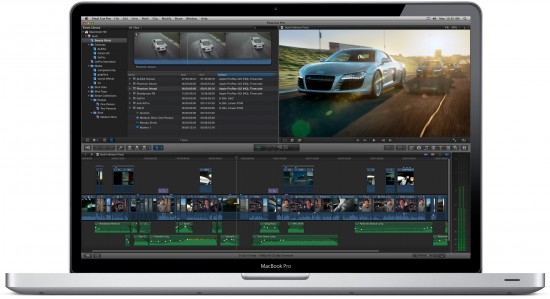During NAB in Las Vegas Apple announced the newest version of Final Cut called Final Cut Pro X. Built from the ground up new features include top to bottom 64-bit support, OpenCL processing and a new interface
64-Bit support, Grand Central Dispatch and OpenCL
One of the largest features announced in Final Cut Pro X is 64-bit and multicore support.
Previous versions only supported 32-bit processes which limited RAM access to 4GBs. As Final Cut Pro started handling High Definition footage, larger file sizes and becoming more common place on more powerful Macs, increased amounts of processing power needed to be utilized more effectively. The shift to 64-bit processing, multicore optimization and OpenCL support allows Final Cut Pro X to efficiently utilize every ounce of processing power in your Mac.
Most Macs ship with 4GB of RAM but Professional users tend to increase the amount to 8, 16 or 32GB depending on their configuration. Being able to access more RAM is a welcome addition to pro users looking to speed up their workflow but the real jump in speed will come from multicore optimization and OpenCL support.
Introduced in Snow Leopard is Apple’s method of more effectively optimizing multiple processor cores called Grand Central Dispatch. Code can run faster and more efficiently on multi-core processors. Even the lowly MacBook Air runs code much faster thanks to Grand Central.
The same feature is being leverage heavily by Snow Leopard to render footage in the background while editing. Making better use of 2 and 4 core processors has effectively killed the notorious render menu which puts Final Cut Pro into an unusable state while effects are applied to footage.
To tap into more processing horsepower is FCP X’s support for OpenCL — or CUDA for non Mac types — which taps in to a machine’s graphics processor to accomplish certain processor intensive tasks much faster. While Final Cut Pro won’t be running entirely on your graphics card, a lot of on the fly rendering will be done on your GPU.
New UI
Final Cut Pro X sports a new user interface and is a dramatic departure from the brushed steel look that dominated past versions of OS X.
At first glance you may mistake Final Cut Pro for iMovie which would shock any professional video editor. “How could a prosumer App look like a consumer video editor?” you may ask. Apple took a few notable features from the latest version of iMovie and improved upon them for pro users.
Aside from aesthetic differences between FCP 7 and X is the new timeline which looks more like iMovie hence the initial confusion. However, Final Cut Pro X doesn’t take on iMovie’s style of editing and instead focuses on speed and new features such as syncing clips based on audio waveforms and better handling of adding audio files to the timeline.
4K Footage Support and Color Sync
Amongst some of the new features in Final Cut Pro X is support for 4K footage, built in color sync and resolution independent playback. If you’re shooting with 4K footage, you can import and edit directly in FCP X and the interface supports scaling from Standard Definition to the aforementioned 4K footage. Another new feature is color sync support. FCP X will compare and match clips based on color. However, Apple has yet to go in to detail about 4K and ColorSync support.
Available Through Mac App Store
![]()
Final Cut Pro X takes a different approach to being sold: the Mac App Store. Apple announced FCP X would be arriving to the Mac App Store in June at $299, significantly less than the $999 Final Cut Studio bundle.
Apple has yet to announce whether or not it will offer the other Final Cut Studio Apps through the Mac App Store but it seems likely. After the introduction of FCP X, Apple mentioned it had nothing to talk about regarding Compressor, Motion and other FCS Apps. That doesn’t mean Apple won’t talk more about it during WWDC.












